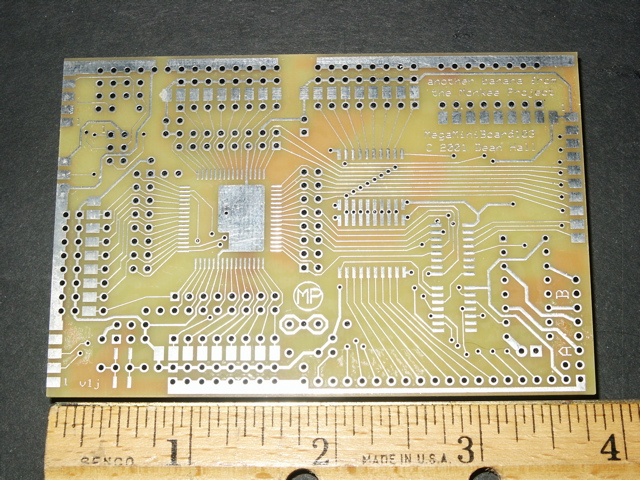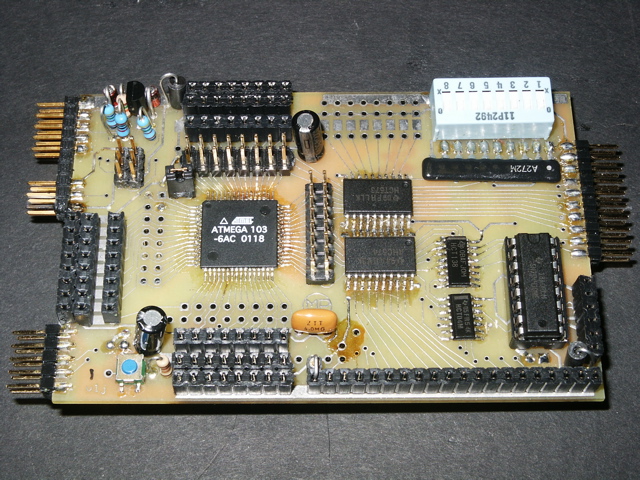|
|
|
Copyright 2001 Dean Hall |
| Contents |
| Introduction |
Since then, I have wanted to design a microcontroller board of my own. When I saw the specs of the Atmel ATmega103 8-bit RISC, I started designing the board straight away [2]. During the year it has taken me to complete the circuit board, procure parts and build and test the MMB103, the GNU Compiler Collection (avr-gcc for Win32) has come to support the Atmel series of microcontrollers (free C!) and Larry Barello announced AvrX, his RTOS for the AVR/ATmega series of controllers (free OS!). So it is in the spirit of the open source community that I present the MMB103.
|
| MMB103 Features |
ATmega103
The processor alone does not a good robot board make.
I have used
my 7 years of robot experience and incorporated good ideas from people
throughout the net to determine the features of the MMB. Here
they
are:
MMB103
The 8-channels of analog input go directly to the 103's ADC. However, the 8-channels of digital input, the 8-bit DIP switch input, and the LCD are all latched to the 103's data bus pins, so they don't consume any extra pins! The 2 port motor driver uses two of the 103's PWM signals to provide variable-speed control of any motor up to 1A. Two enable signals are also latched from the data bus to provide brake/coast ability to the motors. I chose the common TI SN754410 as the motor driver (free samples!). The motor driver is hardwired in the locked-antiphase configuration. I got this idea from Larry Barello who does a good job of explaining the concept. The short story is that the motor driver's Enable pin is always asserted while the 103's PWM signal is connected to the motor driver's Direction pin. This holds the motor at zero rotation when the PWM is at 50% duty cycle (equal amount of forward and reverse current). As the duty cycle increases from 50% the motors spin in one direction; and as the duty cycle decreases from 50% the motors spin in the other direction. One advantage of locked-antiphase is observed when a robot drives down a ramp: the PWM method used by the Handyboard lets the robot increase in velocity as it decends the ramp; the locked-antiphase method absorbs that kinetic energy back into the battery and constrains the speed of the robot. The LCD connector is very flexible due to the two data latches connected to the data bus. The first 14 pins are for the common 2x16 through 4x20 LCD character displays. I've also seen some 20-pin graphics LCD displays that share the same pinout for pins 1-14. Unfortunately, B.G. Micro sold out of them long ago (I only have one left and I'm keeping it). Regardless, this port can be programmed to accommodate most small LCD displays. A MAX233 level converter allows the 103's UART to talk to a PC's serial port. With the 103 clocked at 4MHz, a 19200bps connection works reliably with only 0.2% error. If you're worried that you don't see it in the picture, the MAX233 is hidden on the back of the board. I am a big proponent of SPI. I've used it to network 4 HC11's and I'm using it here. SPI provides a serial digital network at high speeds (4Mbps on board, 1Mbps at 3 meters over twisted pair). I will use this to allow multiple MMB103s to communicate. I am going to use the SNAP protocol to allow the OS to send and receive kernel messages (true kernel-level multiprocessor multi-threading!). The MMB103 Circuit BoardI originally drew the MMB103 circuit board layout using ExpressPCB's free software layout program. I did this so that I could post the single .sch file and others could use that file and have the board fabricated for themselves. I ordered my first three prototype boards through ExpressPCB and was very pleased with the quick turnaround, low price and acceptable quality.It took me over a month to draw the board and another month to verify the traces because the layout and schematic tool (from another vendor) were not integrated. Even after the long verification, I accidently drew three trace defects. I knew an integrated schematic/layout tool would alleviate this pain, but I thought ExpressPCB would be easier for Joe Public. Larry Barello convinced me that it would be better to use an integrated tool and suggested Eagle. I had read of Eagle but had never used it. I have redrawn most the MMB103's schematics using Eagle (it takes a little while to get used to it) and I plan to use it for the next/final version of the MMB103 layout.
|
| The Software |
The number one reason I chose the Atmel AVR/ATmega family of processors was the free C compiler, avr-gcc. avr-gcc runs on Linux and Win32 systems. The number two reason for choosing the AVR/ATmega was Larry Barello's AvrX RTOS. |
| Conclusion |
The MMB103 is a robot controller board that has numerous hardware features and plenty of software opportunities. When the hardware is debugged and the software libraries are in a beta quality stage, I plan to release the MMB103 project to the robot community. Along the way, I might upgrade to the pin-compatible ATmega128, yielding the MMB128. |
| References |
|
| License |
The MMB103 circuit board artwork and all software are Copyright 2001 Dean Hall. All rights reserved. |
| Copyright 2001 Dean Hall |

